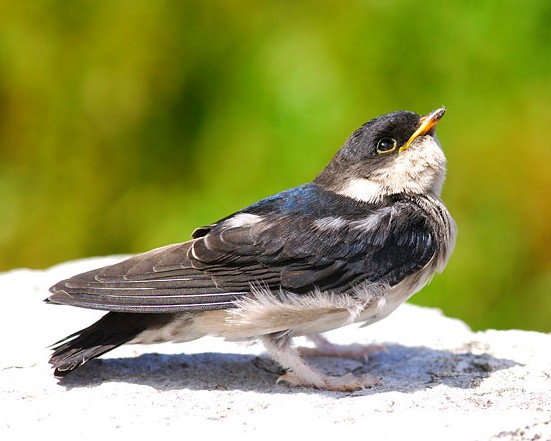Asian House Martin
A species of House-martins Scientific name : Delichon dasypus Genus : House-martins
Asian House Martin, A species of House-martins
Botanical name: Delichon dasypus
Genus: House-martins
Content
Description General Info
Description
The adult Asian house martin of the nominate subspecies is 12 cm (4.7 in) long, dark steel blue above with a contrasting white rump, grey-washed white underparts, and a slightly forked tail. The tail and upperwings are brownish-black, and the underwings are grey-brown. The legs and feet are brownish-pink and covered with white feathers, the eyes are brown, and the bill is black. There are few differences in appearance between the sexes, although the male is somewhat whiter below than the female, especially in fresh plumage. The juvenile bird is less glossy and has dark brown upperparts, sometimes with a brownish wash to the rump, and grey-white underparts. D. d. cashmiriensis has brighter blue upperparts and a whiter rump than the slightly larger nominate race. The third, smallest, race is D. d. nigrimentalis. All three subspecies can be distinguished from the similar Nepal house martin by the latter species' black chin, black undertail coverts and much squarer tail. The Asian house martin is more similar to the common house martin, but is darker underneath and has a less deeply forked tail. Confusion is most likely between adult male Asian house martins, which have paler underparts, and the eastern race of common house martin, D. urbicum lagopodum which has a less forked tail than the western subspecies, although it still shows a more pronounced fork than Asian. This species’ song is a rippling metallic trill, and is a sibilant twitter, and call is a dry metallic cheep, often with two or three syllables. It is similar to that of common house martin, but more rasping. 
Size
13 cm
Nest Placement
Building
Feeding Habits
Asian House Martin predominantly consumes flying insects such as flies, aphids, and ants. Additionally, it captures other insects like moths, beetles, and lacewings. Occasionally, it forages on the ground for springtails and caterpillars, showcasing its dietary diversity and adaptability.
Habitat
Asian House Martin can typically be found in mountainous regions, occupying valleys, and gorges. They are also commonly seen along sea coasts and have adapted well to human habitations. These birds prefer areas with general environmental conditions that include rugged terrain and are frequently associated with higher altitude landscapes.
Dite type
Insectivorous
General Info
Feeding Habits
Bird food type
Distribution Area
The nominate subspecies of the Asian house martin, D. d. dasypus, breeds in the southeast of Russia, the Kuril Islands, Japan and sometimes Korea. It migrates through eastern China to winter in the Malay Peninsula, Borneo, the Philippines, Java and Sumatra; a few birds remain around hot springs in Japan. D. d. cashmeriensis breeds in the Himalayas from Afghanistan east to Sikkim and northwards into Tibet and western and central China. It is found between 1,500–5,000 m (4,900–16,400 ft) altitude, although mainly in the 2,400–4,000 m (7,900–13,100 ft) range. This martin is a short-range migrant, mainly wintering at lower altitudes in the foothills of the Himalayas, but with some birds on the plains of North-eastern India and North-eastern and South-eastern Bangladesh, and smaller numbers further afield in Myanmar and northern Thailand. The third race, D. d. nigrimentalis, breeds in southeastern China and southern Siberia. Its wintering grounds are unknown, but birds in Taiwan just move to lower altitudes in winter. Non-breeding Asian house martin have been recorded as far west as the United Arab Emirates. The range of D. d. cashmeriensis overlaps with that of the Nepal house martin, although they breed at somewhat different altitudes. The height separation and the small differences in appearance seem sufficient to prevent interbreeding. The preferred habitat of the Asian house martin is valleys and gorges in mountainous areas or coastal cliffs, where natural caves or crevices provide nest sites. It will also breed on large man-made sites like temples, hotels or power stations. This martin tends to move to lower altitude open or hilly country in its wintering areas, although it has been recorded at up to 2,565 m (8,415 ft) in Thailand. 
Species Status
The Asian house martin has a large range that does not appear to be contracting, and its numbers appear to be stable, although the total population is unknown. Since the range is more than 20,000 square kilometres (7,700 sq mi), and there are more 10,000 mature individuals, in the absence of any large decline in distribution or numbers the species does not appear to meet the criteria to be considered vulnerable, and is currently evaluated as Least Concern. This species is locally abundant and appears to be expanding its range northwards in southern Siberia. 
Scientific Classification
Phylum
Chordates Class
Birds Order
Perching birds Family
Swallows Genus
House-martins Species
Asian House Martin 